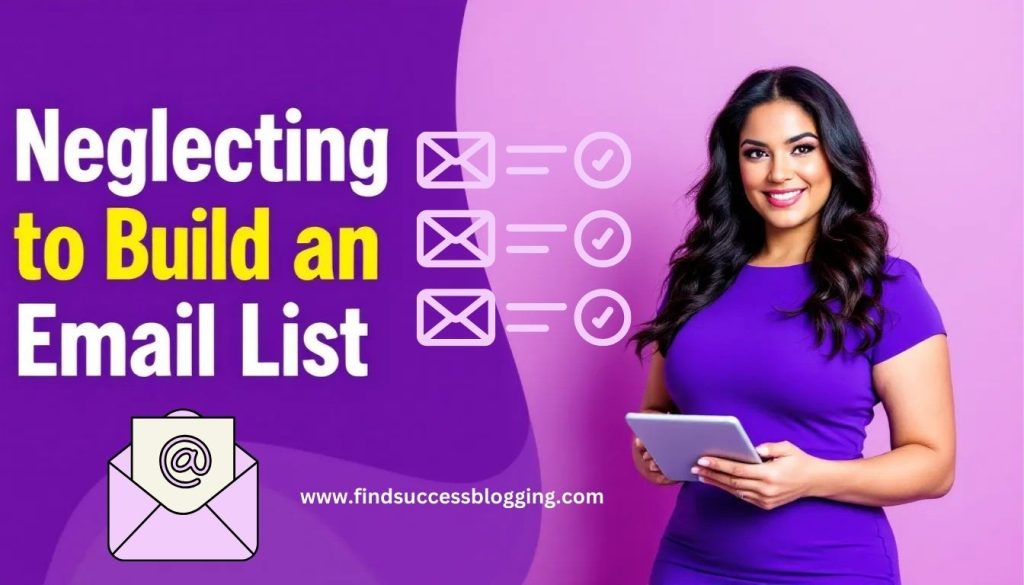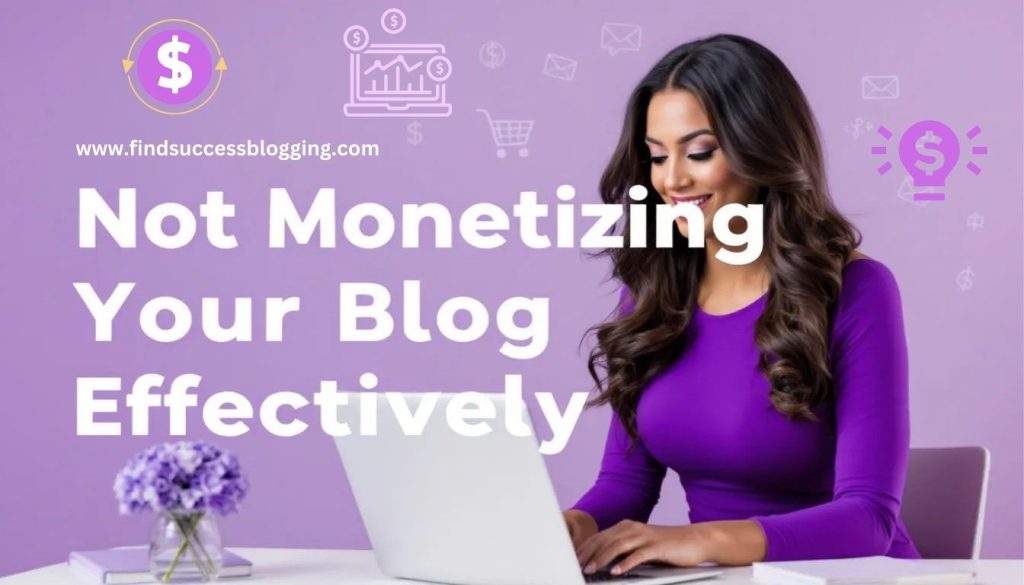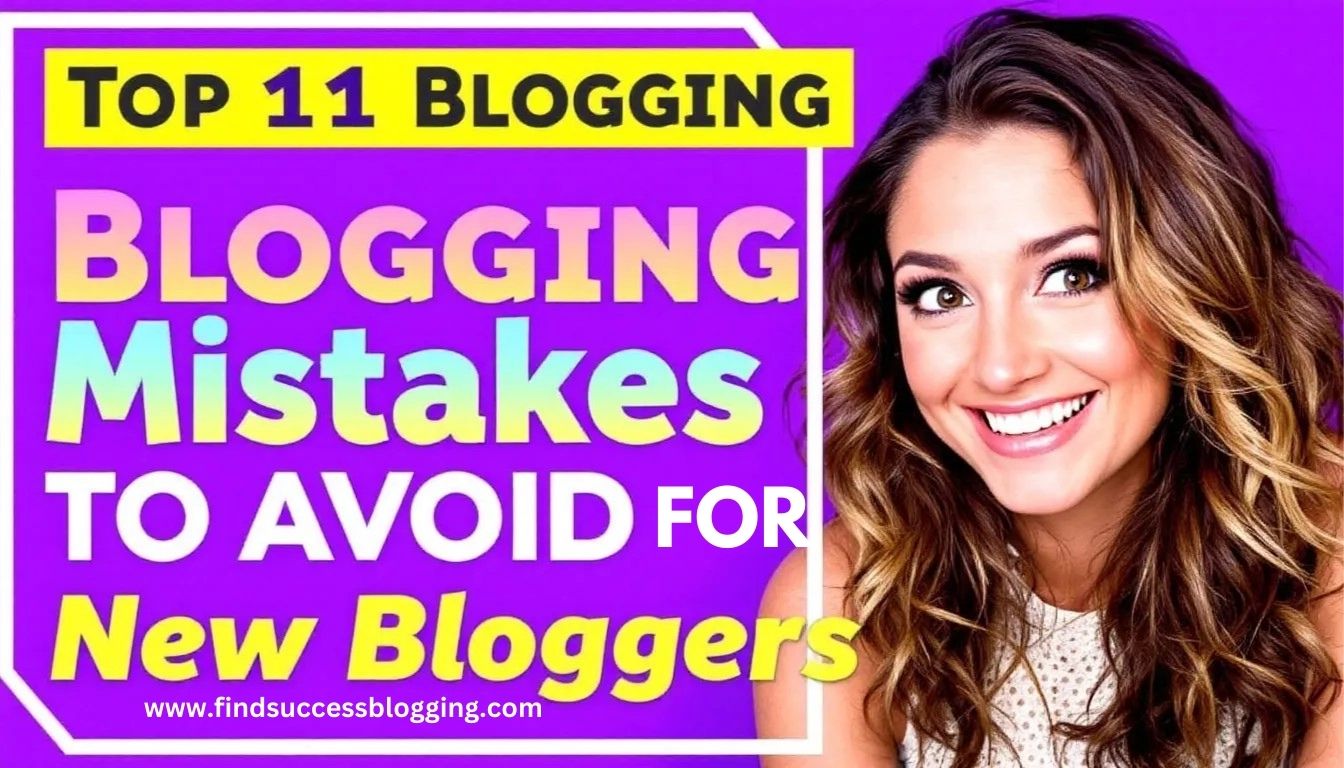Blogging mistakes to avoid for new bloggers are crucial aspects of blogging success if you recognize them early.
Did you know that over 600 million blogs exist worldwide, but only 32% of bloggers report “strong results”?
If you’re new to the blogging game, you probably wonder, “How can I be part of that successful minority?” Well, you’re in luck!
Today, you will discover how to avoid blogging mistakes I didn’t recognize when starting a new blog. So, your blogging journey will be flawless and successful. Let’s get rolling.
Table of Contents
ToggleTop 11 Blogging Mistakes To Avoid For New Bloggers To Skyrocket Their Success
Are you tired of pouring your heart into blog posts nobody seems to read? Imagine having a blog that attracts readers and keeps them returning for more.
When you avoid common blogging mistakes, you’ll readily create a successful blog that outranks competitors. Below are the top 11 blogging mistakes to avoid for new bloggers.
1. Neglecting to Define Your Target Audience
In blogging mistakes to avoid for new bloggers, one of the most critical errors is failing to define your target audience.
I’ve seen countless newbie bloggers dive headfirst into content creation without really knowing who they’re writing for. Trust me, I’ve been there, and it’s like trying to hit a bullseye while blindfolded!
Understanding the importance of knowing your audience
Let’s face it—you can’t please everyone and shouldn’t even bother. Your blog needs a clear focus, starting with identifying your ideal reader.
Knowing who you’re talking to makes your content more relevant, engaging, and valuable. It’s like conversing with a friend rather than shouting into the void.
Tools and techniques for audience research
- Surveys: Create simple questionnaires to gather insights from your readers or potential audience.
- Social media analytics: Dive into your social media insights to understand who’s engaging with your content.
- Google Analytics: This powerhouse tool can reveal demographic information and interests of your website visitors.
- Competitor analysis: Study successful blogs in your niche to see who they’re targeting and how.
How to create reader personas
Imagine your ideal reader. Give them a name, age, occupation, and interests. What problems do they face? What solutions are they seeking?
When you create these fictional but data-informed personas, you’ll have a clearer picture of who you’re writing for.
| Summary: Defining your target audience is the compass that guides your blogging journey. It helps you create content that resonates, builds a loyal community, and ultimately leads to blogging success. |
2. Inconsistent Posting Schedule
Another crucial blogging mistake to avoid for new bloggers is an inconsistent posting schedule.
In my initial blogging journey, I’d write whenever inspiration struck—which sometimes meant weeks between posts. Big mistake!
The impact of irregular posting on reader engagement
Imagine your favorite TV show airing new episodes randomly without warning. Frustrating, right?
That’s how your readers feel when your posting schedule becomes inconsistent. Consistency builds trust and anticipation. When readers know when to expect new content, they’ll likely return and engage with your blog regularly.
Tips for creating a sustainable content calendar
- Be realistic: Start with a posting frequency you can maintain. It’s better to post quality and comprehensive content once a week than to burn out trying to post daily.
- Plan: Map out your content ideas at least a month in advance.
- Use scheduling tools: Platforms like WordPress allow you to write and schedule posts for publication in advance.
- Batch your content: Set aside specific days for writing multiple posts, which can maintain consistency during busy periods.
Balancing quality and quantity in your posting schedule
While consistency is key, it shouldn’t come at the expense of quality. It’s not about churning mediocre content just to stick to a schedule.
Find the sweet spot where you can consistently produce high-quality posts. Remember, having fewer, well-crafted posts is better than a flood of subpar content.
| Summary: A consistent posting schedule is like a promise to your readers. It builds trust, keeps them coming back for more, and helps establish your blog as a reliable source of information in your niche. |
3. Ignoring SEO Basics
One of the most common blogging mistakes to avoid for new bloggers is overlooking the fundamentals of Search Engine Optimization (SEO).
I get it. When I started, SEO sounded like a complex topic that I’d rather avoid. But trust me, ignoring it is like hiding your blog under a rock!

Essential SEO practices to implement from day one
- Keyword Research 🔍
- Use tools like Google Keyword Planner or Ubersuggest to find relevant keywords
- Focus on long-tail keywords for easier ranking opportunities
- Aim for a mix of informational and commercial keywords
- On-Page Optimization 📝
- Include your target keyword in your title, URL, meta description, and throughout your content naturally
- Use header tags (H1, H2, H3) to structure your content logically
- Optimize images with descriptive file names and alt text
- Technical SEO 🔧
- Ensure your site is mobile-friendly
- Improve page load speed (use tools like GTmetrix to analyze and optimize)
- Set up XML sitemaps and submit them to search engines
- Content Quality and Relevance 📚
- Create in-depth, valuable content that addresses user intent
- Aim for a minimum of 1,500 words for main content pages
- Update old content regularly to keep it fresh and relevant
- Link Building 🔗
- Start internal linking from day one
- Guest post on reputable sites in your niche
- Create shareable content that naturally attracts backlinks
Common SEO mistakes new bloggers make
- Keyword stuffing: Overusing keywords makes your content sound unnatural and can lead to penalties.
- Ignoring meta descriptions: These snippets are your ad copy in search results—make them interesting!
- Neglecting mobile optimization: With mobile-first indexing, your blog must be mobile-friendly.
- Forgetting page speed: Slow-loading pages frustrate users and hurt your search rankings.
Learn Top 13 Blogging for Business Success Secrets Revealed
Tools to improve your blog’s search engine visibility
- Google Search Console: This free tool helps you monitor and maintain your site’s presence in Google Search results. Besides, it’s free to use.
- Yoast SEO (for WordPress): Offers real-time page analysis and helps optimize your content for target keywords.
- SEMrush: Provides comprehensive SEO analysis, including keyword research and competitor analysis.
- Screaming Frog: Helps identify technical SEO issues on your site.
| Summary: SEO isn’t about tricking search engines – it’s about making your content easily discoverable by search engines and readers. When you master these basics, you lay a solid foundation for your blog’s long-term success in the digital world. |
4. Failing to Promote Your Content
One of the biggest blogging mistakes to avoid for new bloggers is creating great content and then… crickets.
You can’t just hit publish and expect the readers to come flocking. Trust me, I’ve been there—sitting behind my screen, wondering why my brilliant posts weren’t getting any traction. The truth is promotion is just as important as creation!
The 80/20 rule of content creation vs. promotion
Have you ever heard of the Pareto Principle? Regarding blogging, it suggests spending 20% of your time creating content and 80% promoting it.
I know it sounds counterintuitive, but think about it—what’s the point of writing if no one’s reading? Don’t let your hard work go to waste!
Effective strategies for promoting your blog posts
- Email marketing: Build an email list and send newsletters featuring your latest posts.
- Social media sharing: Craft engaging social media posts to drive traffic to your blog. Check out our guide on social media marketing for bloggers for more tips!
- Blogger outreach: Connect with other bloggers in your niche and explore collaboration opportunities.
- Content repurposing: Turn your blog posts into videos, infographics, or podcasts to reach a wider audience.
Leveraging social media for blog promotion
- Choose the right platforms: Focus on where your target audience hangs out.
- Use hashtags strategically: Research popular hashtags in your niche to increase visibility.
- Engage with your audience: Respond to comments and participate in relevant conversations.
- Share at optimal times: Use tools like Hootsuite or Buffer to schedule posts when your audience is most active.
| Summary: promotion isn’t about being pushy—it’s about getting valuable content in front of the right eyes. A solid promotion strategy can turn your blog from a hidden gem into a go-to resource in your niche. |
5. Overlooking the Importance of Visuals
In the blogging world, another crucial blogging mistake to avoid for new bloggers is underestimating the power of visuals.
I remember how my initial blogging posts were just walls of text—not exactly inviting. Let’s face it: we’re visual creatures, and incorporating eye-catching images can create an exciting world.
The role of images and videos in engaging readers
- Breaking up text: Visuals give your reader’s eyes a break while making your content more digestible.
- Enhancing understanding: Complex concepts can often be explained better with infographics or diagrams.
- Boosting social shares: Posts with images get shared more often on social media platforms.
- Improving SEO: Properly optimized images can help your blog posts rank better in image search results.
Tools for creating eye-catching visuals
- Canva: A user-friendly graphic design tool perfect for creating custom blog images and infographics.
- Piktochart: Great for creating more complex infographics and data visualizations.
- Unsplash or Pexels: Sources for high-quality, free stock photos to complement your content.
- Lumen5: Turn your blog posts into engaging video content.
Best practices for optimizing images for web and SEO
- Use descriptive file names: Instead of “IMG_1234.jpg”, use “blogging-mistakes-to-avoid.jpg.”
- Add alt text: Describe your image for accessibility and SEO purposes.
- Compress images: Use tools like TinyPNG to reduce file sizes without compromising quality.
- Choose the right format: Use JPEGs for photographs and PNGs for graphics with text.
|
Summary: Don’t overlook your brilliant content because of lackluster presentation. When incorporating compelling visuals, you’re not just making your blog more attractive. Instead, you’re enhancing the overall user experience and increasing the chances of your audience sharing and remembering your content. |
6. Neglecting to Build an Email List
If there’s one thing I wish I’d started doing from day one, it’s building an email list. It is among the most critical blogging mistakes to avoid for new bloggers.

I used to think, “Why bother with emails when I have social media?” Boy, was I wrong!
Why email lists are crucial for blog growth
- Direct communication: Unlike social media, where algorithms dictate who sees your content, emails land directly in your subscribers’ inboxes.
- Higher engagement: Email subscribers are often more engaged than social media followers.
- Ownership: Unlike your social media following, you own your email list, which could disappear if the platform changes.
- Monetization opportunities: An email list can be a powerful tool for promoting products or services.
Strategies for growing your email subscribers
- Offer a compelling lead magnet: Create a valuable freebie (like an ebook or checklist) in exchange for email addresses.
- Use opt-in forms strategically: Place sign-up forms in high-visibility areas of your blog.
- Create content upgrades: Offer additional resources related to specific blog
- Run a contest or giveaway: Encourage entries via email sign-ups.
Check Effective Blog Monetization to Diversify Your Income Streams
Creating valuable lead magnets
- Solve a problem: Address a specific problem your audience faces.
- Make it actionable: Provide practical, easy-to-implement advice.
- Ensure high quality: Your lead magnet should showcase your expertise.
- Keep it concise: Respect your readers’ time with focused, to-the-point content.
| Summary: Building an email list is like cultivating a garden—it takes time and effort, but the rewards are worth it. It’s one of the most effective ways to nurture relationships with your readers and turn casual visitors into loyal fans. |
7. Poor Website Design and User Experience
When learning about blogging mistakes to avoid for new bloggers, neglecting your website’s design and user experience is like inviting guests to a party in a messy, poorly lit house.
No matter how great your content is, visitors who can’t navigate your site easily will leave faster than you can say “bounce rate.”
Key elements of user-friendly blog design
- Clean and intuitive navigation
- Mobile responsiveness
- Fast loading speeds
- Readable typography
- Consistent color scheme and branding
Let’s break these down. First, your navigation should be as clear as a summer sky. Imagine your reader is a tourist in a new city—your menu is their map. Make it easy to find and use.
Next up is mobile responsiveness. With over 50% of web traffic coming from mobile devices, your blog needs to look good on screens of all sizes. It’s like being a chameleon, adapting to any environment.
Now, let’s talk about website speed. In the digital world, patience is as rare as a unicorn. If your site takes over 3 seconds to load, you might simply frustrate your readers’ desire to read your blog.
Use tools like GTmetrix to check your site speed and optimize accordingly.
In addition, typography might seem a minor issue, but it differentiates between a pleasant read and an eye-straining ordeal.
So, choose appealing fonts and maintain consistency throughout your blog.
Lastly, your site color scheme and branding should be consistent with your grandma’s secret recipe. It helps build recognition and trust with your audience.
Common design mistakes that drive readers away
Here’s a table explaining blogging mistakes in website design.
| Mistake | Impact | Solution |
| Cluttered layout | Overwhelms visitors | Embrace white space |
| Autoplay videos/music | Annoys users | Let users control media |
| Tiny, low-contrast text | Reduces readability | Use larger, high-contrast fonts |
| Excessive pop-ups/Ads | Interrupts user experience | Use pop-ups and ads sparingly and strategically |
| Broken links | Frustrates users and hurts SEO | Regularly audit and fix broken links |
Tools and resources for improving your blog’s aesthetics
- WordPress themes: Start with a solid foundation. Themes like Astra or Kadence offer great customization options.
- Canva: Create stunning graphics and maintain visual consistency across your blog.
- Google Fonts: Access a wide range of web-safe fonts to enhance typography.
- ColorHunt: Find beautiful color palettes to elevate your blog’s visual appeal.
- Hotjar: Use heatmaps and user recordings to understand how visitors interact with your site.
Remember, your blog’s design is like the cover of a book—it might not tell the entire story, but it sure makes a first impression. Make it count!
| Summary: Good website design and user experience are about making your readers feel at home. It’s about creating a space where they can easily find what they’re looking for, enjoy their stay, and want to return for more. Don’t let poor design be the reason your brilliant content goes unread. |
8. Writing for Yourself Instead of Your Audience
Ah, the classic blunder of writing for an audience of one—yourself. This is one of the most sneaky blogging mistakes to avoid for new bloggers because it often masquerades as authenticity.
But here’s the truth bomb: while being true to yourself is important, ignoring your audience’s needs is like hosting a dinner party and only serving your favorite food, regardless of your guests’ preferences or allergies.
Balancing personal passion with reader interests
Picture your blog as a seesaw. On one side, you’ve got your passions and expertise. On the other, your readers’ interests and needs. Your job is to find that sweet spot where both sides are perfectly balanced.
Here’s a simple 3-step process to achieve this balance:
- Identify your passions: List the topics you could talk about for hours without getting bored.
- Research your audience: Use tools like Google Analytics and social media insights to understand what your readers are interested in.
- Find the overlap: Look for topics that appear on both lists. That’s your content goldmine!
Remember, it’s not about completely abandoning your interests. It’s about finding creative ways to align them with what your audience wants to read.
Techniques for identifying popular topics in your niche
- Use Google Trends: This free tool shows your audience research in real time. It’s like having a crystal ball for content ideas!
- Analyze competitors: Watch what successful bloggers in your niche are writing about. Tools like BuzzSumo can show you their most shared content.
- Engage in social listening: Monitor relevant hashtags and join niche-specific groups on social media. It’s like eavesdropping on your audience’s conversations (in a non-creepy way).
- Leverage keyword research: Tools like Ubersuggest or Ahrefs can reveal what your audience is searching for online.
- Ask your audience directly: Surveys, polls, or simply asking for feedback can provide invaluable insights. It’s like having a direct line to your readers’ minds!
How to use reader feedback to guide your content strategy
Imagine reader feedback as a GPS for your blogging journey. Here’s how to use it effectively:
- Encourage comments: End your posts with questions to spark discussion. Respond to comments promptly to keep the conversation flowing.
- Monitor email responses: If you have a newsletter, consider which topics generate the most replies.
- Track social shares: Notice which posts get shared the most. This action is a clear indicator of what resonates with your audience.
- Evaluate your analytics: Look for patterns in your most popular posts. What do they have in common?
- Create content buckets: Based on feedback, create categories of content that your audience loves. Use these to guide your content calendar.
Case Study: The Blog Tyrant
Ramsay Taplin, the founder of Blog Tyrant, used reader feedback to pivot his content strategy completely.
He noticed his audience engaged more with posts about growing email lists. When he focused more on this topic, he saw a 40% increase in subscriber growth.
| Summary: Writing for your audience doesn’t mean losing your voice. It means using your unique perspective to address topics your readers care about. It’s about creating content that’s like a perfectly tailored suit—a great fit for you and your audience. |
9. Failing to Network with Other Bloggers
In the vast digital landscape, isolation is among the blogging mistakes to avoid for new bloggers.
Think of the blogosphere as a bustling city—you wouldn’t set up shop without getting to know your neighbors, right?

Networking isn’t just about making friends; it’s about creating a support system, learning from others, and opening doors to opportunities you might never have discovered.
Benefits of building relationships in the blogging community
- Knowledge exchange: Every blogger has unique experiences and insights. By networking, you’re gaining access to a wealth of collective wisdom.
- Collaboration opportunities: From guest posting to joint webinars, partnerships can help you reach new audiences and create exciting content.
- Emotional support: Let’s face it: blogging can be lonely. Having a network means you have people who understand your struggles and celebrate your wins.
- SEO boost: Natural backlinks often come from relationships you’ve built with other bloggers.
- Industry insights: Stay ahead of trends and algorithm changes by tapping into the collective knowledge of your network.
Discover 13 Lucrative Passive Income Ideas for Bloggers in 2024
Strategies for effective blogger outreach
Reaching out to other bloggers can feel like asking someone to dance at a middle school party—awkward but potentially rewarding. Here’s how to make it less cringe-worthy:
Start with genuine engagement: Comment on their posts, share their content and interact on social media before making any requests.
Personalize your approach: Generic messages are the fast track to the ignore list. Show that you’ve read their content and have something valuable.
Offer value first: Whether sharing a helpful resource or offering to promote their content, lead with what you can do for them.
Be clear and concise: Respect their time by getting to the point, but don’t forget to be friendly and authentic.
Follow up, but don’t bug: If you don’t hear back, a polite follow-up is okay. After that, refrain and move on.
Collaborative opportunities to grow your audience
| Collaboration Type | Description | Benefits |
| Guest Posting | Write content for each other’s blogs | Exposure to new audiences, backlinks |
| Podcast Interviews | Appear as a guest on industry podcasts | Showcase expertise, reach audio audience |
| Joint Webinars | Co-host online workshops or discussions | Combine audiences, demonstrate expertise |
| Roundup Posts | Feature multiple bloggers’ insights in one post | Network building, content creation |
| Social Media Takeovers | Manage each other’s social accounts for a day | Cross-promotion, audience engagement |
| Summary: Networking in the blogging world is like tending a garden. It requires patience, regular attention, and genuine care. But the fruits of your labor—a supportive community, collaborative opportunities, and organic growth—are worthwhile. |
10. Giving Up Too Soon
The blogging journey is a marathon, not a sprint. One of the most heartbreaking blogging mistakes to avoid for new bloggers is quitting before giving your blog a real chance to flourish.
It’s like planting a seed and expecting a fully grown tree overnight—unrealistic and unfair to your potential.
Understanding the realistic timeline for blog growth
Let’s break down a typical blog growth timeline:
1-3 Months : The Seedling Stage
- Focus: Consistent content creation, establishing your voice
- Expectations: Low traffic, minimal engagement
- Action: Set up analytics, start building your email list
4-6 Months: The Sprouting Phase
- Focus: Content refinement, SEO implementation
- Expectations: Gradual traffic increase, some returning visitors
- Action: Network with other bloggers, guest post opportunities
7-12 Months: The Growth Spurt
- Focus: Content promotion, monetization strategies
- Expectations: Steady traffic growth, increased engagement
- Action: Analyze top-performing content and create more of what works
Year 2: The Blooming Period
- Focus: Scaling strategies, diversifying content
- Expectations: Significant traffic increase, loyal readership
- Action: Explore new content formats, consider products or services
Remember, these timelines vary based on niche, effort, and strategy. The key is to stay patient and persistent.
Strategies for staying motivated during slow periods
- Celebrate small wins: Did someone leave a thoughtful comment? Did your subscriber count increase by one? Toast to these moments!
- Join a blogging community: Surrounding yourself with like-minded individuals can provide support and inspiration during tough times.
- Revisit your ‘why’: Keep your initial motivation for starting a blog visible. It’s your North Star during cloudy nights.
- Learn continuously: Use slow periods to upskill. Take a course on SEO, brush up on your writing skills, or learn about email marketing.
- Experiment with content: Slow periods are perfect for trying new things. Maybe it’s time to start that podcast or create your first video.
Setting achievable goals and tracking progress
Goal-setting in blogging is like using a GPS on a road trip. Here’s how to do it effectively.
- Use the SMART framework:
Specific: “Increase blog traffic” → “Increase organic traffic by 20%.”
• Measurable: Use tools like Google Analytics to track progress
• Achievable: Be ambitious but realistic
• Relevant: Align goals with your overall blogging strategy
• Time-bound: Set a deadline, e.g., “in the next 3 months.” - Break big goals into smaller milestones:
Publish two blog posts per week
• Reach out to 1 new blogger for collaboration each month
• Implement three new SEO strategies this quarter - Use a goal-tracking system:
Tools like Trello or Asana can help visualize your progress
• Regular check-ins (weekly or monthly) to assess and adjust - Reward yourself:
• Set up a reward system for achieving milestones
• It could be as simple as a favorite treat or as big as a new blogging tool
Case Study: Melyssa Griffin
Melyssa Griffin, a successful blogger and online entrepreneur, shares how she pushed through the initial slow growth of her blog.
She emphasizes the importance of consistency and patience, revealing that it took her several months of blogging before she started seeing significant traction.
Today, her blog generates over seven figures annually.
| Summary: Success in blogging is often just around the corner from giving up. By understanding realistic timelines, staying motivated, and setting achievable goals, you’re setting yourself up for long-term success. Remember, every successful blogger you admire once started exactly where you are now. |
11. Not Monetizing Your Blog Effectively
One of the most frustrating blogging mistakes to avoid for new bloggers is leaving money on the table.

Many bloggers pour their heart and soul into creating fantastic content but struggle to turn their passion into profit.
It’s like baking the world’s best cookies but forgetting to put up a “For Sale” sign! Common monetization mistakes new bloggers make.
- Rushing into monetization too soon
Why it’s a problem: Without a solid audience, monetization efforts often fall flat
• Solution: Focus on building a loyal readership first - Relying solely on display ads
Why it’s a problem: Low earning potential, especially for new blogs
• Solution: Diversify income streams (we’ll cover this in a moment) - Promoting products you don’t believe in
Why it’s a problem: Erodes trust with your audience
• Solution: Only promote products or services you’ve used and genuinely recommend - Neglecting email marketing
Why it’s a problem: Email lists are golden for monetization
• Solution: Start building your list from day one - Inconsistent monetization strategy
• Why it’s a problem: Sporadic efforts lead to sporadic results
• Solution: Develop a consistent, long-term monetization plan
Diverse income streams for bloggers
Let’s explore the blogging money tree and its various branches.
- Affiliate Marketing 🔗
What it is: Earn commissions by promoting other people’s products
• Pro tip: Choose products relevant to your niche and audience
• Example: A fitness blogger promoting workout equipment or nutrition supplements - Digital Products 💻
What it is: Create and sell your ebooks, courses, or templates
• Pro tip: Start with a small, low-priced product to test the waters
• Example: A productivity blogger selling a digital planner - Sponsored content 🤝
What it is: Partnering with brands to create content featuring their products
• Pro tip: Be transparent about sponsored posts to maintain trust
• Example: A travel blogger partnering with a luggage company for a review post - Coaching or Consulting 🗣️
What it is: Offering one-on-one or group sessions in your area of expertise
• Pro tip: Start with a few free sessions to build confidence and testimonials
• Example: A personal finance blogger offering budget coaching sessions - Membership Sites 🔒
• What it is: Offer exclusive content or community access for a recurring fee
• Pro tip: Ensure you can consistently provide value to justify the recurring cost
• Example: A food blogger creating a membership site with exclusive recipes and cooking tutorials
Remember, diversification is key. Don’t put all your eggs in one monetization basket!
Balancing monetization with user experience
The art of monetization lies in balancing earning potential and user satisfaction. Below are ways to strike that balance.
- Value first, monetize second.
Prioritize providing value to your audience
• Monetization should enhance, not detract from, the user experience - Be transparent
Clearly disclose affiliate relationships and sponsored content
• Your audience will appreciate your honesty - Maintain content quality
Don’t let the pursuit of profit compromise your content standards
• High-quality, valuable content will naturally lead to monetization opportunities - Test and optimize
Regularly analyze which monetization methods resonate with your audience
• Be willing to pivot if something isn’t working - Keep ads minimal and relevant
• If using display ads, ensure they don’t overwhelm your content
• Use ad networks that serve relevant, high-quality ads
Discover the top 10 proven strategies to monetize your blog
Case Study: Making Sense of Cents
Michelle Schroeder-Gardner of Making Sense of Cents is a prime example of effective blog monetization.
She started her personal finance blog in 2011 and now earns over $100,000 monthly through affiliate marketing, digital products, and sponsored content.
Michelle emphasizes the importance of diversifying income streams and always providing value to her readers. You can learn more about her monetization strategies in her detailed income reports: Making Sense of Cents Income Reports.
| Summary: Effective monetization is about creating a win-win situation. When done right, it allows you to earn a living while continuing to provide value to your audience. Remember, your blog is not just a hobby—it’s a business. Treat it as such, and the rewards will follow. |
Conclusion on Blogging Mistakes to Avoid for New Bloggers
We’ve covered a lot of ground regarding blogging mistakes to avoid for new bloggers, haven’t we?
From defining your target audience to effectively monetizing your blog, these critical elements separates successful bloggers from failures.
Remember, the blogging journey is a marathon, not a sprint. It takes time, effort, and a willingness to learn from your successes and failures.
But I hope this comprehensive guide has equipped you with the knowledge and strategies to overcome common pitfalls and set your blog up for long-term triumph.
The key is staying focused, adaptable, and passionate about your work. Keep creating valuable content, connecting with your audience, and exploring new ways to grow your blog.
Also, don’t be afraid to ask for help—the blogging community has generous souls who’ve been in your shoes.
FAQs
1. What are the biggest blogging mistakes for beginners to avoid?
The biggest blogging mistakes to avoid for new bloggers include neglecting SEO, failing to build an email list, and inconsistent posting schedules.
Others include ineffective content promotion, ignoring the importance of visuals, and not monetizing the blog properly.
2. How can new bloggers avoid the mistake of writing only for themselves?
To avoid writing just for themselves instead of their target audience, new bloggers should 1) Identify their passions and expertise, 2) Research what their audience is interested in, and 3) Find the balance where those two overlap.
Regularly engaging with readers and analyzing analytics can also help guide the content strategy.
3. Why is it important for new bloggers to network with other bloggers in their niche?
Networking with other bloggers offers knowledge sharing, collaboration opportunities, emotional support, SEO boosts from backlinks and industry insights. Effective outreach strategies involve providing value first before making any asks.
4. How long does it typically take for a new blog to start seeing significant growth?
Blog growth usually follows a timeline:
- 1-3 Months (low traffic, focus on consistent content),
- 4-6 Months (gradual traffic increase, SEO and networking),
- 7-12 Months (steady traffic growth, monetization),
- Year 2 (significant traffic, loyal readership).
However, timelines can vary based on niche, effort, and strategy.
5. What are some tips for new bloggers to stay motivated during the slow growth phase?
Tips to stay motivated include celebrating small wins, joining a blogging community, revisiting your “why,” continuously learning new skills, and experimenting with content. Also, consider setting achievable, trackable goals with a reward system.
6. How can new bloggers find the right balance between monetization and user experience?
To balance monetization and user experience, new bloggers should:
- Prioritize value over profits
- Be transparent about sponsored/affiliate content
- Maintain high-quality content standards
- Test and optimize monetization methods
- Use ads sparingly and ensure relevance.
| So, are you ready to take your blog to new heights? Embrace these lessons, put in the work, and watch your little corner of the internet flourish. The world is waiting for your stories, so let’s begin!
Don’t forget to subscribe to our newsletter for updates on our latest posts. |
Related posts:
- 15 Common Blogging Mistakes to Avoid for a Successful Blog
- 10 Basics Blogging Tips For New Bloggers To Appear Professional
- Top 7 Blogging Tips for New Bloggers to Launch a Successful Blog
- 10 Tips for Successful Affiliate Marketing for New Bloggers
- Top 10 Proven Blogging Tips for Success in your Business








